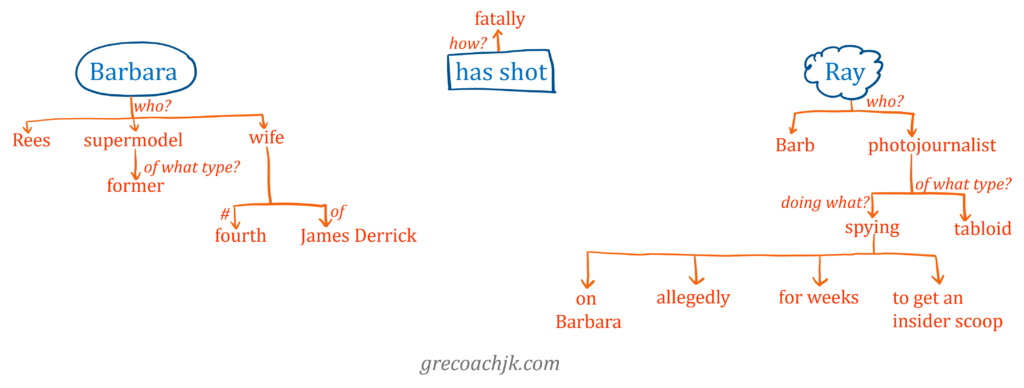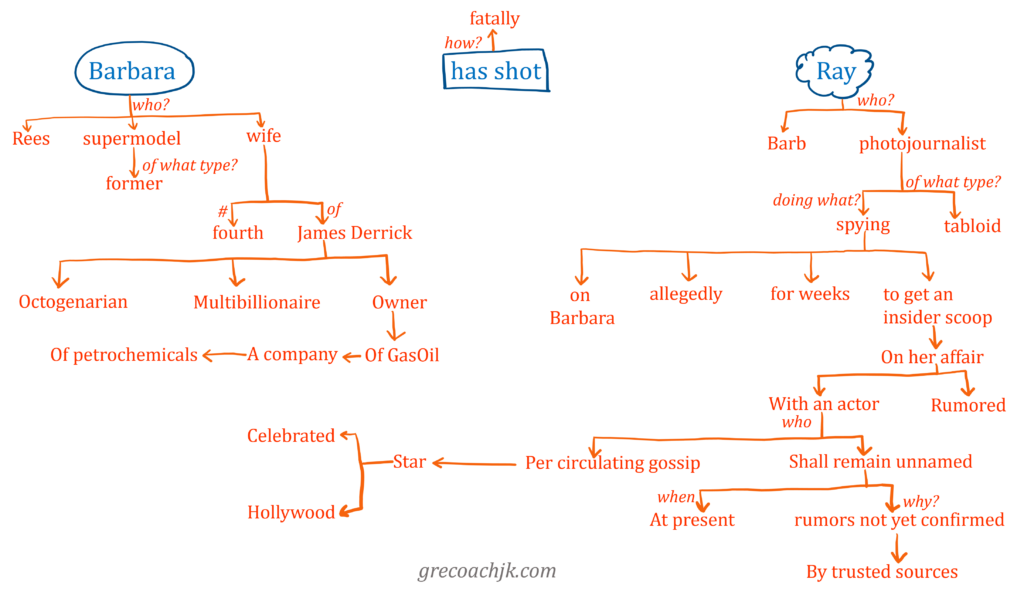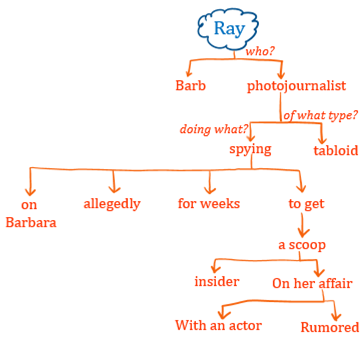This article is organized as follows:
We will start with an example sentence, using which I will explain how to read tough, long sentences. A summary of my reading strategy will follow. After this, you will practice this reading strategy on five sentences. To enable you to check your performance, I have provided videos of my own reading for these sentences.
Let’s begin!
Ms Barbara Rees, a former supermodel and the fourth wife of James Derrick, the octogenarian multibillionaire owner of GasOil, a petrochemicals company, has fatally shot Ray Barb, a tabloid photojournalist who had allegedly been spying on her for weeks to get an insider scoop on her rumored affair with an actor who, as per the circulating gossip, is a celebrated Hollywood star but who shall remain unnamed at present as the rumors of his liaison with Ms Rees have not yet been confirmed by trusted sources.
This jumbo sentence is 86-words long! It seems to be written by a blabbermouth who keeps piling on more information before one has a chance to make sense of what he’s already said.
Some GRE verbal passages have sentences like this that just seem to go on and on, leaving students utterly lost in a jungle of words.
How can you find your way in this jungle? Let’s see.
The key idea to remember is that all words in a sentence are NOT equal. The 80/20 Pareto principle applies to sentence comprehension: 80 percent of your mental imagery (and, therefore, your understanding) of a sentence will come from just 20 percent of its words. These image-forming words are the most important words in a sentence. They are:
- The Subject, who is the doer of an action
- The Verb, which denotes the action that is being done
- The Object, the thing to which the action is done.

So, when faced with a sentence like the jumbo example one, first seek to identify only the subject (S), the verb (V) and the object (O) of the sentence. Among these three, the verb is often the easiest to identify. Ask yourself – what happens in this sentence? Barbara shoots somebody. So, the ‘verb’ will be the word/words that convey(s) this action.
- Verb: has shot
(Ignore the ‘fatally’ for now. It only gives additional information about the shooting. Shot how? Fatally, slowly, angrily . . .these are all extra details. At present, we are focusing our attention on only the most important words in a sentence.)
Who did the shooting? Barbara. So, she is the subject.
- Subject: Barbara
Who was shot? Ray. So, he is the object.
- Object: Ray
Read out aloud the basic sentence that has no words other than the subject, the verb, and the object. For our jumbo example, the basic sentence will be:
Barbara has shot Ray.
What label should we give to this SVO-only version of the jumbo sentence? You may call it just that – ‘the SVO-only version’ – but I also like to call it ‘the basic sentence’, ‘the skeletal sentence’ or the ‘barebones sentence,’ because just as a skeleton defines the frame of a body on which all the meat hangs, the SVO-only version is the frame of a sentence on which all the other words hang. You’ll find me using these four labels interchangeably in this article and the embedded videos.
I’ll also explicitly state here a rule of English grammar that you already use intuitively: the subject, the verb and the object always occur in this very order (first S, then V, then O).
Getting back to our skeletal sentence, now that we have it in place, we can put all the other words – the meat – in the jumbo sentence on the parts of the skeleton that they belong to.
Starting with Barbara, what does the jumbo sentence tell us about her?
- Barbara
- Ms Rees
- supermodel
- (Further information: what kind of supermodel?) former
- wife
- (Further information: what kind of wife?) fourth
- (Further information: whose wife?) of James Derrick
Then the sentence goes on to tell us more about James Derrick. We will ignore this information at present because we are only interested in Barbara. We want to first put the meat on all the words in our skeletal sentence (the Subject, the Verb, and the Object). Then, we will return to James Derrick and see what the author has blabbered about him.
Moving on to the verb, ‘has shot.’ Barbara has shot how? “Fatally,” meaning that the shot person died from the gun wound.
So, for the verb ‘has shot,’ we just have one unit of information – just one bullet point, and that one bullet point too has no sub-bullets to it:
- has shot
- fatally
Next comes the Object, Ray. Let’s see what information we have regarding him:
- Ray
- Surname: Barb
- Photojournalist
- (where? At a) tabloid
- (doing what?) Spying
- on Barbara
- Allegedly (meaning, this is just an allegation; we are not yet sure that he was in fact spying.)
- For weeks
- To get an insider scoop
Then the sentence gives us further details about what he was hoping to get an insider scoop on. We will ignore this extra information for now.
So, let’s see how we have understood the sentence so far, by stitching together the first-level bullet points only for the Subject, the Verb and the Object.
Ms. Barbara Rees, supermodel and wife, has fatally shot Ray Barb, a photojournalist.
No problems in understanding this time, right?
We can also draw a mind map of all the words that we have understood so far as follows:

Now we are ready for all those extra layers of fat, all that information about James Derrick and the insider scoop.
Let’s start with the man:
James Derrick:
- Octogenarian
- Multibillionaire
- Owner
- Of GasOil
- A company
- Of petrochemicals
- A company
- Of GasOil
Similarly, for insider scoop, we can bullet and sub-bullet the information units provided as follows:
Insider scoop:
- On her affair
- Rumored
- With an actor
- Per circulating gossip
- Star
- (what kind of?) Celebrated
- (where?) Hollywood
- Shall remain unnamed
- At present
- (because/as) rumors not yet confirmed
- By trusted sources.
- Star
- Per circulating gossip
We will append all these new information units that we have unpacked to the mind map that we drew before. So, our final mind map for the jumbo sentence is this:

Takeaways
Here is a consolidated list of the sentence reading ideas discussed through the Barbara example:
- Know that all words in a jumbo sentence are not equal. The Subject (S), the Verb (V), and the Object (O) are the most important.
- In your first reading, just aim to piece together the basic/barebones/skeletal sentence. This is the SVO-only version. Tune out all the other words in the sentence as ‘blah blah’ words. They are not important in this first reading.
- Once the skeletal sentence is in place, then, start putting meat on the S, V and O respectively by processing the given details about each. At this stage, ignore all the tertiary details, which are (further info)-about – (further info about S/V/O) type details. For example, James Derrick was one of the further information units about Barbara; any further info about James Derrick should be ignored at this stage.
- Once the meat is put on the S, V and O, then start putting the remaining words where they belong in the sentence. This is the stage where we process all the info about James Derrick in our example jumbo sentence.
Bulleting and sub-bulleting a sentence or drawing a mind map of a sentence as you process it are two visualization techniques that I find to be helpful in making sense of the sentence as we read it. Between these, I find mind mapping to be more robust; bulleting and sub-bulleting a jumbo sentence takes up a lot of space, and the more space it takes, the more difficult it becomes for you to understand all the main pieces in one quick look. A mind map, on the other hand, enables you to take in all the relationships in the sentence in one glance.
You will soon see five sentences. Try reading each on your own first, in the manner we read the Barbara jumbo sentence. Draw a mind map for each. Then, compare your work with mine. I have provided sentence-wise videos of my own reading and mind mapping.
Two notes for the practice exercise
Note 1
Your mind maps may look slightly different from mine. For example, in the jumbo version of the Barbara sentence, for the node ‘spying’, one of the child-nodes in my mind map is ‘to get an insider scoop.’ Instead of keeping it in one piece as I have done, you may choose to break it further down in the following manner:
- spying
- to get
- (what?) a scoop
- (what kind of scoop?) insider
- (scoop on what?) on her affair
- (what?) a scoop
- to get
So, your mind map will show this child-node of ‘spying’ as ‘to get’ and then, ‘to get’ will have a child-node of its own – ‘a scoop’ – which will further have two children, ‘insider’ and ‘on her affair.’

(the child-nodes of ‘with an actor’ have been ignored in this mind map, for simplicity of representation)
This version is exactly right (technically more correct than my mind map above). I have made a stylistic choice to not depict separately the child- and grandchild- nodes for ‘to get’ and to instead put all these words together as a single node ‘to get an insider scoop.’ This choice simplified my mind map, I think, and it also enabled me to fit ever word/phrase of the jumbo sentence within a single PowerPoint slide.
So, when evaluating your work on the five practice sentences, remember that mind mapping is a subjective art. Your mind map may be perfectly fine even if it does not match exactly with mine. If you have identified the S, V and O correctly for a sentence, and if the mind mapping has enabled you to understand the sentence correctly, then your effort has been successful.
Note 2
Drawing mind maps now for these five sentences does not mean that you will always have to draw mind maps to understand jumbo sentences. I am encouraging you to draw them now because this is a practice worksheet. By making your work tangible, by actually drawing out the relationships you perceive between the words, you will be better able to spot misunderstandings, if any. Doing this exercise with just a few sentences is likely to be sufficient for you to be able to do such mind mapping just in your head.
The practice set begins now.
5 Practice Sentences
Mammals
“The evolution of intelligence among early large mammals of the grasslands was due in great measure to the interaction between two ecologically synchronized groups of these animals, the hunting carnivores and the herbivores that they hunted.”
This 36-words-long sentence opens an official RC passage (OG Chapter 5 Set 4).
Photographs
“One of the major reasons photo collecting has flowered only recently was the realization that a photograph, unlike a painting or a drawing, can be reproduced forever, as long as the negative exists.”
This 33-words-long sentence is taken from the book Developing Reading Skills: A Practical Guide to Reading Comprehension Exercises, by Francoise Grellet
Company
“The computer company reported strong second-quarter earnings that surpassed Wall Street’s estimates and announced the first in a series of price cuts intended to increase sales further.”
This 27-words-long sentence is taken from GMAT OG-VR.
Sunspots
“The absence of recorded sunspot activity in the notes kept by European observers in the late seventeenth and early eighteenth centuries has led some scholars to postulate a brief cessation of sunspot activity at that time (a period called the Maunder minimum).”
This 42-words-long sentence is taken from an RC passage in the GRE Big Book, Test 1
Promulgation
“The promulgation of a sweeping set of standards for America’s schools has triggered a widening protest from state and local officials, who complain that the administration is interfering with their own education reform efforts and usurping what traditionally has been a jealously guarded realm of state and local initiative.”
This 49-words-long sentence is taken from the academic paper A Case for the Sentence in Reading Comprehension, by CM Scott, 2009
Did you find this article to be useful? Would you like to have more sentences for comprehension practice? Drop me a LinkedIn message. I will really appreciate your feedback and suggestions.